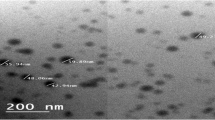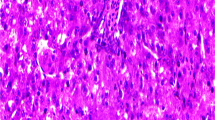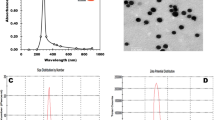Abstract
Supplementation of selenium in poultry feed is required in an optimum dose and form for optimizing the growth performance and health status. Selenium nanospheres are suggested as an efficient and alternative to the conventional organic or inorganic forms. The study evaluated the effects of selenium (Se) nanospheres (SeNPs) as an alternative to organic Se (Sel-Plex®) or inorganic Se (sodium selenite, Se(IV Se(IV)) on the growth performance, carcass traits, blood biochemistry, and antioxidative capacity in turkey pullets. A total of 160 1-day-old Bronze turkey poults chicks were divided into four groups with 40 pullets each. The birds were fed on four types of diets as fellow: control (basal diet, 0.01 Se mg/kg), SeNPs (0.43 Se mg/kg), organic Se Sel-Plex® (0.41 Se mg/kg), and inorganic Se(IV) (0.42 Se mg/kg) for 8 weeks. No changes were seen in the body weight gain in growing turkey pullet, but chicks fed with Sel-Plex® form recorded the lowest feed intake (p < 0.05) compared to other treatments. Dietary SeNPs and Se(IV) selenium sources improved the feed conversion ratio compared to other treatments. All Se forms fed on turkey pullets showed higher carcass percentage weight and liver Se content than the control group. However, the gizzard percentage weight in the SeNPs group was lower than in the other treatments (p < 0.05). Birds fed SeNPs, and Sel-Plex® forms supplemental diets had a lower cholesterol concentration (p < 0.05) than the control and Se(IV). While high-density lipoprotein (HDL) concentration was increased in SeNPs and Se(IV) groups, and total protein concentration was higher in the Se(IV) group. Furthermore, dietary SeNPs reduced (p < 0.05) the low-density lipoprotein (LDL), total lipids, triglycerides, alanine aminotransferase (ALT), aspartate aminotransferase (AST), creatine, uric acid, urea, and malondialdehyde plasma concentrations and increased the glutathione peroxidase activity (GPx) and total antioxidative capacity (TAC). In conclusion, the results confirmed that feeding turkey pullets on SeNPs form with the 0.4 Se mg/kg of feed enhanced feed efficiency, growth performance, carcass traits, plasma lipids concentration, and antioxidative capacity.

Similar content being viewed by others
Availability of Data and Materials
The datasets generated during and/or analyzed during the current study are available from the corresponding author on reasonable request.
Code Availability
Not applicable.
References
Elnaggar AS et al (2020) Impact of selenium sources on productive and physiological performance of broilers. Egypt Poult Sci J 40(3):577–597
Abdelnour SA et al (2021) Nanominerals: fabrication methods, benefits and hazards, and their applications in ruminants with special reference to selenium and zinc nanoparticles. Animals 11(7)
Wang Y (2009) Differential effects of sodium selenite and Nano-Se on growth performance, tissue Se distribution, and glutathione peroxidase activity of Avian broiler. Biol Trace Elem Res 128(2):184–190
Oliveira TFB et al (2014) Effect of different sources and levels of selenium on performance, meat quality, and tissue characteristics of broilers. J Appl Poult Res 23(1):15–22
Han XJ et al (2017) Effect of sodium selenite and selenium yeast on performance, egg quality, antioxidant capacity, and selenium deposition of laying hens. Poult Sci 96(11):3973–3980
El-Deep MH et al (2020) In ovo injection of nano-selenium spheres mitigates the hatchability, histopathology image and immune response of hatched chicks. J Anim Physiol Anim Nutr 104(5):1392–1400
Abd El-Kader MF et al (2021) Selenium nanoparticles act potentially on the growth performance, hemato-biochemical indices, antioxidative, and immune-related genes of European seabass (Dicentrarchus labrax). Biol Trace Elem Res 199(8):3126–3134
Ursini F, Maiorino M (2013) Glutathione peroxidases. In: Lennarz WJ, Lane MD (eds) encyclopedia of biological chemistry (Second Edition). Academic Press, Waltham, pp 399–404
Pouri S et al (2018) Biological synthesis of selenium nanoparticles and evaluation of their bioavailability. Braz Arch Biol Technol 60
Schrauzer GN (2001) Nutritional selenium supplements: product types, quality, and safety. J Am Coll Nutr 20(1):1–4
Payne RL, Southern LL (2005) Comparison of inorganic and organic selenium sources for broilers12. Poult Sci 84(6):898–902
Choct M, Naylor AJ, Reinke N (2004) Selenium supplementation affects broiler growth performance, meat yield and feather coverage. Br Poult Sci 45(5):677–683
Skrivan M et al (2006) Effect of dietary sodium selenite, Se-enriched yeast and Se-enriched Chlorella on egg Se concentration, physical parameters of eggs and laying hen production. Czeh J Anim Sci 51(4):163
Surai PF (2002) Natural antioxidants in avian nutrition and reproduction. Nottingham University Press Nottingham
Whanger PD (2002) Selenocompounds in plants and animals and their biological significance. J Am Coll Nutr 21(3):223–232
Połatajko A et al (2005) Investigation of the recovery of selenomethionine from selenized yeast by two-dimensional LC–ICP MS. Anal Bioanal Chem 381(4):844–849
Albrecht MA, Evans CW, Raston CL (2006) Green chemistry and the health implications of nanoparticles. Green Chem 8(5):417–432
Visha P et al (2015) Biosynthesis and structural characteristics of selenium nanoparticles using Lactobacillus acidophilus bacteria by wet sterilization process. Int J Adv Vet Sci Technol 4(1):178–183
Kaler A et al (2011) Extracellular biosynthesis of silver nanoparticles using aqueous extract of Candida viswanathii. J Bionanosci 5(1):53–58
Dhillon GS et al (2012) Green approach for nanoparticle biosynthesis by fungi: current trends and applications. Crit Rev Biotechnol 32(1):49–73
Zommara MA, Prokisch J (2019) Conversion of inorganic selenium to organic form (s) by Lactobacillus acidophilus. Alex J Food Sci Technol 16(2):17–24
Zommara M, Prokisch J (2015) Selenium rich yoghurt: bio-fortification for better health. Egypt J Dairy Sci 43(2):159–167
Pophaly SD et al (2014) Selenium enrichment of lactic acid bacteria and bifidobacteria: a functional food perspective. Trends Food Sci Technol 39(2):135–145
Cai SJ et al (2012) Effects of nano-selenium on performance, meat quality, immune function, oxidation resistance, and tissue selenium content in broilers. Poult Sci 91(10):2532–2539
Lee SH et al (2014) Effects of in ovo injection with selenium on immune and antioxidant responses during experimental necrotic enteritis in broiler chickens1. Poult Sci 93(5):1113–1121
Pelyhe C, Mézes M (2013) Myths and facts about the effects of nano selenium in farm animals–mini-review. Eur Chem Bull 2(12):1049–1052
Marković R et al (2018) The effects of dietary Selenium-yeast level on glutathione peroxidase activity, tissue Selenium content, growth performance, and carcass and meat quality of broilers. Poult Sci 97(8):2861–2870
Ahmadi M, Ahmadian A, Seidavi AR (2018) Effect of different levels of nano-selenium on performance, blood parameters, immunity and carcass characteristics of broiler chickens. Poult Sci J 6(1):99–108
Taylor RM, Sunde RA (2016) Selenoprotein transcript level and enzyme activity as biomarkers for selenium status and selenium requirements in the turkey (Meleagris gallopavo). PLoS One 11(3):e0151665
Taylor RM, Sunde RA (2017) Selenium requirements based on muscle and kidney selenoprotein enzyme activity and transcript expression in the turkey poult (Meleagris gallopavo). PLoS One 12(11):e0189001
Prokisch J et al (2008) Formation of metal selenium nanospheres in bacteria: is it a possible detoxification mechanism? Cereal Res Commun 36:947–950
Zommara M et al (2007) Utilization of whey from the manufacture of Kareish cheese enriched with organic selenium in bread making. in The 10th International Conference for Dairy Science and Technology
NRC, National Research Council (1994) Nutrient requirements of poultry. 9 edn. Nat., Acad. Press, Washington
AOAC (2012) Official methods of analysis of AOAC international. 19th edition. AOAC International, Gaithersburg. www.eoma.aoac.org
Høstmark AT et al (1989) Plasma lipids, lipoproteins, and fecal excretion of neutral sterols and bile acids in rats fed various high fat diets or a low fat/high sucrose diet. J Nutr 119(3):356–363
Mikulski D et al (2009) The effect of selenium source on performance, carcass traits, oxidative status of the organism, and meat quality of turkeys. J Anim Feed Sci 18:518–530
Taylor RM, Bourget VG, Sunde RA (2019) High dietary inorganic selenium has minimal effects on turkeys and selenium status biomarkers. Poult Sci 98(2):855–865
Downs KM, Hess JB, Bilgili SF (2000) Selenium source effect on broiler carcass characteristics, meat quality and drip loss. J Appl Anim Res 18(1):61–71
Deniz G, Gezen S, Turkmen I (2005) Effects of two supplemental dietary selenium sources (mineral and organic) on broiler performance and drip-loss. Rev Méd Vét 156(8/9):423
Naylor A, Choct M, Jacques K (2000) Effects of selenium source and level on performance and meat quality in male broilers. Poult Sci 79(Suppl 1):117
Zhou X, Wang Y (2011) Influence of dietary nano elemental selenium on growth performance, tissue selenium distribution, meat quality, and glutathione peroxidase activity in Guangxi Yellow chicken. Poult Sci 90(3):680–686
Edens F, Parkhurst C, Havenstein G (1999) Selenium yeast (Sel-Plex 50) improves feathering rate of broilers reared in either conventional or cage environments. Poult Sci 78:133
Ravindran V, Elliott S (2017) Influence of selenium source on the performance, feathering and meat quality of broilers. J Appl Anim Nutr 5
Hu CH et al (2012) Comparative effects of nano elemental selenium and sodium selenite on selenium retention in broiler chickens. Anim Feed Sci Technol 177(3):204–210
Petrovič V et al (2006) Antioxidant and selenium status of laying hens fed with diets supplemented with selenite or Se-yeast. J Anim Feed Sci 15(3):435–444
Pan C et al (2007) Effect of selenium source and level in hen’s diet on tissue selenium deposition and egg selenium concentrations. J Agric Food Chem 55(3):1027–1032
Attia Y et al (2010) Effect of inorganic or organic selenium supplementation on productive performance, egg quality and some physiological traits of dual-purpose breeding hens. Czeh J Anim Sci 55(11):505–519
Yang Y et al (2012) Effect of organic and inorganic selenium supplementation on growth performance, meat quality and antioxidant property of broilers. Afr J Biotechnol 11(12):3031–3036
Invernizzi G et al (2013) Effects of inclusion of selenium-enriched yeast in the diet of laying hens on performance, eggshell quality, and selenium tissue deposition. Ital J Anim Sci 12(1):e1
Saleh AA (2014) Effect of dietary mixture of Aspergillus probiotic and selenium nano-particles on growth, nutrient digestibilities, selected blood parameters and muscle fatty acid profile in broiler chickens. Anim Sci Pap Rep 32(1):65–79
Wang C et al (2011) Effects of copper-loaded chitosan nanoparticles on growth and immunity in broilers. Poult Sci 90(10):2223–2228
Hassanin KMA, Abd El-Kawi SH, Hashem KS (2013) The prospective protective effect of selenium nanoparticles against chromium-induced oxidative and cellular damage in rat thyroid. Int J Nanomed 8:1713–1720
Li KX et al (2018) Effects of different selenium sources and levels on antioxidant status in broiler breeders. Asian Australas J Anim Sci 31(12):1939–1945
Jing CL et al (2015) Comparative study of DL-selenomethionine vs sodium selenite and seleno-yeast on antioxidant activity and selenium status in laying hens. Poult Sci 94(5):965–975
Behne D, Kyriakopoulos A (2001) Mammalian selenium-containing proteins. Annu Rev Nutr 21(1):453–473
Zhang S et al (2013) Effects of selenium and vitamin E on nutrient apparent digestibility, nitrogen balance, energy metabolism and blood biochemical indices of beef cattle. Chin J Anim Nutr 25(6):1219–1228
Ramezani S et al (2011) Effect of selenium and sodium bicarbonate supplementation diets on blood biochemical properties, growth performance and carcass traits of broilers in heat stress condition. Vet J 13–22
Acknowledgements
This work was financially supported by the project “Biological production of nano selenium spheres and its application in livestock production” by the National Strategy for Genetic Engineering and Biotechnology, Academy of Scientific Research and Technology, Egypt. The work was funded by Taif University Researchers Supporting Project number (TURSP-2020/76), Taif University, Taif, Saudi Arabia.
Funding
This work was financially supported by the project “Biological production of nano selenium spheres and its application in livestock production” by the National Strategy for Genetic Engineering and Biotechnology, Academy of Scientific Research and Technology, Egypt. The work was funded by Taif University Researchers Supporting Project number (TURSP-2020/76), Taif University, Taif, Saudi Arabia.
Author information
Authors and Affiliations
Contributions
Conceptualization: Samya E. Ibrahim, Mohammed H. Alzawqari, Yahya Z. Eid, and Mohsen Zommara. Data curation: Samya E. Ibrahim, Mohammed H. Alzawqari, and Yahya Z. Eid. Formal analysis: Samya E. Ibrahim and Mohammed H. Alzawqari. Funding acquisition: Samya E. Ibrahim, Mohammed H. Alzawqari, Yahya Z. Eid, Mohsen Zommara, Aziza M. Hassan, and Mahmoud A.O. Dawood. Methodology: Samya E. Ibrahim, Mohammed H. Alzawqari, Yahya Z. Eid, Mohsen Zommara, Aziza M. Hassan, and Mahmoud A.O. Dawood. Resources: Samya E. Ibrahim, Mohammed H. Alzawqari, Yahya Z. Eid, Mohsen Zommara, Aziza M. Hassan, and Mahmoud A.O. Dawood. Supervision: Yahya Z. Eid, Mohsen Zommara, and Mahmoud A.O. Dawood. Writing—original draft: Yahya Z. Eid, Mohsen Zommara, and Mahmoud A.O. Dawood. Writing—review and editing: Aziza M. Hassan and Mahmoud A.O. Dawood. All authors have read and agreed to the published version of the manuscript.
Corresponding authors
Ethics declarations
Ethics Approval and Consent to Participate
The experimental procedure was approved by the ethics review board of the Institutional Animal Care and Use Committee in Kafrelsheikh University (Kafrelsheikh, Egypt).
Consent for Publication
Not applicable.
Competing Interests
The authors declare no competing interests.
Additional information
Publisher's Note
Springer Nature remains neutral with regard to jurisdictional claims in published maps and institutional affiliations.
Supplementary Information
Below is the link to the electronic supplementary material.
Rights and permissions
About this article
Cite this article
Ibrahim, S.E., Alzawqari, M.H., Eid, Y.Z. et al. Comparing the Influences of Selenium Nanospheres, Sodium Selenite, and Biological Selenium on the Growth Performance, Blood Biochemistry, and Antioxidative Capacity of Growing Turkey Pullets. Biol Trace Elem Res 200, 2915–2922 (2022). https://doi.org/10.1007/s12011-021-02894-w
Received:
Accepted:
Published:
Issue Date:
DOI: https://doi.org/10.1007/s12011-021-02894-w




